As I’ve written elsewhere, Linseed oil is one of my favorite dry finishes. The first time around, I had my doubts about its strength and applicability, but my biggest concern was its smell. Upon opening the bottle of linseed oil, you can detect a non-neutral smell. And this might make you wonder if the smell gets transferred to the final finish.
Linseed oil does smell when it is wet, and so does any surface that is covered with a coat of this oil. However, as the oil dries, the smell goes away, leaving behind a neutral-smelling and polished-looking surface.
In this article, you will learn everything you need to know about linseed oil and how it smells, including what you can do to get rid of its odor and whether the smell naturally goes away. Above all, you will learn about a simple product that can accelerate the smell-reduction of linseed oil. So, bookmark this post and continue reading.

What Does Linseed Smell Like?
Linseed oil smells like an earthy nut oil reminiscent of sesame seeds. The smell can be considered pleasant or unpleasant, depending on your preferences. It has smoky base notes with sunflower top notes. The heat is quite nutty, and the oiliness of the finish is detectable in its smell.
Even if you like the nutty smell, it is hard to be exposed to it perpetually. You can get used to the smell of linseed oil if you’re exposed to it for 5 minutes, but the moment you are away from the source of the smell, you become sensitive to it again.
In other words, if your wooden floor or cabinets are coated in linseed oil, and you’re in the room, you won’t notice the smell after five minutes. But upon leaving the room and coming back, you’ll pick up on it.
This gets old really fast, which is why the question most people ask immediately after covering anything in linseed oil is whether they have to live with the smell.
Does Linseed Oil Smell Go Away?
Linseed oil smell goes away when it dries completely and stops getting oxidized with environmental exposure. This can take over 30 days but can be sped up by sunlight exposure and proper ventilation. Fresh air picks up the scent molecules leaving behind fewer smell-causing particles.

Generally, the linseed oil smell should go away, but in some cases, it lingers much longer than it has to.
Here are the reasons why the linseed oil smell is not going away.
- The air is trapped – If there is no ventilation or the air is still, the smelly particles are stranded in the air.
- The oil hasn’t dried – The drying process of the linseed oil also vaporizes the compounds in the oil that cause the signature linseed oil smell.
- The finish is too thick – If you apply a very thick layer of linseed oil, it can start getting sticky instead of drying clean. This is accompanied by a prolonged smell.
Does Linseed Oil Have a Strong Odor?
Linseed oil has a strong odor when it is applied so thick that it becomes sticky. Otherwise, the smell is linseed oil is bearable and rarely a cause of concern for the average woodworker. People with sensitive noses might find the general smell of linseed oil to be too strong.
Boiled linseed oil can smell bad if the specific drying agents used in it have a strong varnish-like smell. In most cases, a thin layer of linseed oil on mobile surfaces is not an odor crisis. When using linseed oil for a stationary surface like shiplap walls, you have to be more careful.
To avoid strong odor, you must follow these steps:
- Confirm a source of ventilation – If the surface cannot be moved into an open space, you need to check if it has a source of ventilation. Ideally, there should be an exhaust fan, but in its absence, regular fans and at least one window are required.
- Assess the heat – Another thing worth looking into is how the oil will reach the temperature it requires to dry. Mobile surfaces can be moved into the sun, so you have to see whether your region has enough sunlight. For walls and floors, you need to look for a window through which sunlight can enter.
- Test the oil – Take a patch of wood and apply the linseed oil to it, then leave it in the same environment (in which the surface will dry) for one day. If the smell is too strong, you might opt for an alternative finish.
How Do You Get Rid of the Smell of Linseed Oil?
You get rid of the smell of linseed oil by facilitating its oxidation. The sooner the oil is fully dry, the sooner the surface will smell neutral. You can facilitate this oxidation process by promoting airflow and heat exposure.
Here are some of the things you can do to improve oxidation and get rid of the linseed oil smell:
- Use a fan – If oil is applied on an immobile surface (like a fixed cabinet or the floor), you should use the exhaust fan or a regular fan with windows open to allow fresh air to come in.
- Expose the surface – In case the linseed oil is used on a mobile surface (a project you can carry outside), you should place it where the air is not trapped.
- Use heat – When you crack open a window and let the sunlight in or simply carry the project outside and place it in the sun, you speed up the drying process, which decreases the smell.
To assist the drying process, you can use heat or you can use ventilation. The lower the temperature or, the more confined a space, the longer it takes to get rid of linseed oil. The best thing you can do to assist the drying process is to invest in a small fan as heating accessories require more electricity and can be quite costly.
Genesis Twin Fan is one of the best items to buy to get rid of the smell of any finish. I like that it can be used as a personal fan but also has the reversible airflow function, which turns it into a portable exhaust fan.
Of course, for more powerful scents like those of lacquer or hard varnish, you’d need a proper fume extraction. But the genesis fan pair works well for linseed and other dry finish oils.
Genesis Twin Fan High-Velocity Reversible AirFlow Fan
It is best when you have only ceiling fans in a room where the linseed oil finish is drying. The ceiling fans spread air in all directions, and only the portion that reaches the window gets out. This is inefficient and takes longer. If you have a regular standing fan, placing it opposite your window can get rid of the smell quicker than ceiling fans.
But an exhaust fan has the highest rate of getting rid of natural and semi-natural odors. I have used this fan in contexts other than woodworking. When my carpet got wet and started to smell, this fan came in handy.
I didn’t buy it for the linseed oil, but when my tabletop was taking too long to dry, I decided to take this out of the garage. It has a global average rating of 4.5 out of 5 stars from over 6000 reviews and ratings on Amazon and is the cheapest mobile exhaust fan on the marketplace.
Linseed Oil Drying Hacks
By now, you understand that as long as there is ventilation and heat exposure, the linseed oil smell goes away. In this section, we will cover some hacks that can be used to accelerate the speed of oxidation/drying, so the surface can smell normal as soon as possible.
Apply Thin Coats
The longest lingering linseed oil smell is a direct result of wet oil getting trapped in a thick layer. When that happens, the upper layer starts to evaporate, and as its contents become airborne, the air starts to smell.
But because the layer is very thick, the oil coat keeps vaporizing over an unnaturally long period. An impractically thick layer of linseed oil can stay semi-wet and sticky for months. This means the surface will continue to smell for a long period. Applying thin layers of linseed oil is the quickest way to ensure that no aromatic substances get trapped between coats.
This video shows how to apply linseed oil properly so that it dries appropriately.
Video showing how to apply Linseed Oil
Fan the Surface After Every Application
Linseed oil coats are applied one at a time, so you can set aside a drying period between the coats. More important than drying is the aerating period, as you need the loose aromatic substances to be blown away before a new wet layer traps them for later release.

To do this, you should use a small fan. I personally use the fan pair covered above. Simply switching the airflow forward can blow away the smellier contents.
Remove the Excess While the Surface Is Wet
Another hack that not only reduces the smell of linseed oil but ensures that the finish doesn’t get sticky is to soak a surface in the oil and then remove the excess with an absorbent rag. The excess oil can solidify and prevent the lower layer from getting sunlight exposure which actually dries the finish and removes the smell.
You should not push down when using a rag to remove extra oil as the surface might incur scratches. Instead, you should gently rub across while letting the rag absorb the excess oil gradually. Once a portion of the rag is fully soaked, you can switch the rags or change positions, so a dry portion makes contact with the oil.
Watch this video to see how to remove excess oil from a wooden surface if it has become sticky.
Video showing how to remove excess Linseed Oil
Linseed Oil Myths
Having gone over the steps you can take to get rid of the linseed oil smell, and what you can do to speed up the process, it is time to address some myths. If you erroneously believe them, you might think of not using linseed oil.
I have heard them all so I thought it might be best to list these out below. Before you make that choice, check out how my experience, contradicts these myths.
Myth #1: Linseed Oil Smells Rotten
This myth comes from people who have used vegetable oil and other non-drying edible oils to finish wood. Such oils truly smell rotten after a while, which is why they should not be used for wood finishing.
In my experience, linseed oil is comparatively pleasant-smelling, and it retains the same smell towards the end as it does when it is fresh. Time fades its scent and doesn’t make it pungent.
Myth #2: Linseed Oil Smell Is Permanent
I would laugh at this had I not believed it. Before I used linseed oil, I used to think that the scent I could pick up when opening a container of the oil was supposed to last. But it is impossible for linseed oil smell to be permanent when linseed oil itself isn’t permanent.
In my experience, linseed oil smell decreases exponentially, with a bulk of it vanishing over the first three days. After that, you have to bring your nose close to a surface to even detect the smell. Towards the end of two weeks, there’s barely any smell.
Myth #3: Linseed Oil Has Dangerous Fumes
Finally, the myth regarding linseed oil is that its fumes are dangerous and are not even close to the truth. The degree to which this myth is spread is directly proportional to how strong the finish smells.
When someone applies the finish in closed quarters, they might detect a very strong smell and might conclude that the aromatic compounds might be dangerous. The worst this smell has done to me is make my eyes watery. It happened when I applied a thick layer that I had to scrub away after it was semi-dry.
Final Thoughts – Does Linseed Oil Smell?
Linseed oil doesn’t smell permanent though it does have a noticeable odor, especially in the first three days of application. By properly ventilating the space and giving the finished surface exposure to heat and air, you can speed up the pace at which linseed oil loses its smell.





